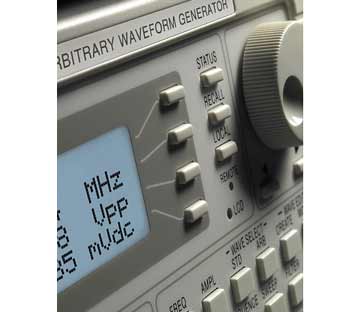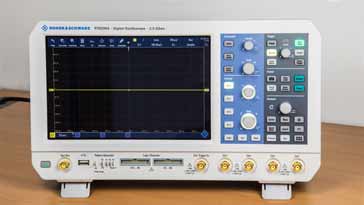Arbitrary Waveform Generator, AWG
An Arbitrary Waveform Generator, AWG, or ARB is a specialised form of function generator that is able to generate waveforms from a set of values entered.
Arbitrary Waveform Generators includes:
Arbitrary waveform generator
Arbitrary function generator
Variable clock AWG
Signal generator types: Signal Generator Basics RF signal generator Function generator Pulse generator
Arbitrary waveforms generators can also be referred to by their initials, AWG, and sometimes they are even called and ARB - short for arbitrary.
The waveforms produced by arbitrary waveform generators, AWGs can be either repetitive or sometimes just a single-shot. If the AWG waveform is only a single shot, then a triggering mechanism is needed to trigger the AWG and possibly the measuring instrument.
The AWG is able to generate an arbitrary waveform defined by a set of values, i.e. "waypoints" entered to set the value of the waveform at specific times. They can make up a digital or even an analogue waveform.
As a result an arbitrary waveform generator is a form of test equipment that is able to produce virtually any waveshape that is required.
Before investing in a separate arbitrary waveform generator test instrument, it is worth investigating whether one already exists and is available. Very many modern oscilloscopes contain an AWG which is integrated into the scope and can often integrate wit the scope functions to capture waveforms.

Arbitrary waveform generators are very similar to function generators, but offer much greater levels of flexibility in terms of waveform generation and they are generally more sophisticated and hence more costly.
Arbitrary Waveform Generator techniques
There are a number of ways of designing arbitrary waveform generators. They are based around digital techniques, and their design falls into one of the main categories below:
- Direct Digital Synthesis, DDS: This type of arbitrary waveform generator is based around the DDS types of frequency synthesizer, and sometimes it may be referred to as an Arbitrary Function Generator, AFG.
- Variable-clock arbitrary waveform generator The variable clock arbitrary function generator is the more flexible form of arbitrary waveform generator. These arbitrary waveform generators are generally more flexible, although they do have some limitations not possessed by the DDS versions. Sometimes these generators are referred to as just arbitrary waveform generators, AWGs rather than arbitrary function generators.
- Combined arbitrary waveform generator This format of AWG combines both of the other forms including the DDS and variable clock techniques. In this way the advantages of both systems can be realised within a single item of test equipment.
Arbitrary waveform generators have been enabled by the advances in digital technology - it can be seen that all the techniques used are digital in concept. With chips like direct digital synthesis, DDS now becoming available at relatively low costs, these enable ARBs to be designed and manufactured far more easily than even a few years ago.
It should also be mentioned that some software to create arbitrary waveforms is available to run on personal computers. Whilst this is a very cheap option to provide one of these test instruments, the output circuitry provided by the PC may limit the capability and performance significantly.
Arbitrary waveform generator resolution and speed
Two of the main specifications for an arbitrary waveform generator are their resolution and also the speed. These two parameters determine the precision with which the waveform can be reproduced. They are governed by different elements within the arbitrary waveform generator circuit.
The amplitude resolution is governed by the resolution of the digital to analogue converter (D/A or D2A). This is described in terms of the number of bits. A 12 bit resolution provides 4096 amplitude steps.
The speed of the arbitrary waveform generator is also very important. The maximum repetition rate for the waveform is governed by two factors: the length of the waveform in terms of the number of samples required to simulate the waveform and the maximum clock frequency. For example if the arbitrary waveform generator had a maximum clock frequency of 25 MHz and the waveform had 1000 points, then the maximum repetition rate would be 25 kHz. If a higher repetition rate was required, then it would be necessary to decrease the number of samples as it would not be possible to increase the clock frequency in the arbitrary waveform generator!

Waveform capture
Before an arbitrary waveform generator can produce a signal it is necessary to enter the points for the required output. There are a number of ways in which the waveform for an arbitrary waveform generator can be captured or generated:
- Capture a real waveform. This can be done using either a digitiser of a digital oscilloscope.
- Use in-built waveform editing on the arbitrary waveform generator. Many AWGs have some degree of waveform generation and editing capability built on board, although this may not be as flexible as a full PC based editing solution.
- Another way is to generate the waveform using software running on a PC. Very sophisticated digital editing software is available for this and allows for many variations to be incorporated.
Either of these methods can be used and then the digital information can be downloaded onto the arbitrary waveform generator to enable it to provide the required output. It should be remembered that not all of the capabilities for waveform capture and entry may be available on all AWGs.

Additional arbitrary waveform generator capabilities
Some arbitrary waveform generators can also operate as conventional function generators. These can include standard waveforms such as sine, square, ramp, triangle, noise and pulse. Some units include additional built-in waveforms such as exponential rise and fall times, sinx/x, etc.. In this way a single instrument can be sued in a variety of applications, even if the full AWG capability is not required, thereby saving he cost of purchasing a variety of generators for what are very similar purposes.
Some arbitrary waveform generators have the ability to output a pattern of words on a multiple-bit connector to simulate data transmission, combining the properties of both AWGs and digital pattern generators.
Arbitrary waveform generator applications
AWGs are used in many applications where specialised waveforms are required. These can be within a whole variety of sectors of the electronics industry.
To give a view of some of the AWG applications, it is possible for DDS-based arbitrary waveform generators is to create signals with precisely controlled phase offsets or ratio-related frequencies. This enables the generation of signals like polyphase sine waves, I-Q constellations, or simulation of signals from geared mechanical systems such as jet engines. Complex channel-channel modulations are also possible.
The arbitrary waveform generator may not be the most widely used of items of test instrumentation, but they can be immensely useful in a variety of applications. Modern arbitrary waveform generators are very flexible and can be used to create very specific waveforms for use in testing a variety of applications. Often AWGs are contained within modern digital oscilloscopes.
 Written by Ian Poole .
Written by Ian Poole .
Experienced electronics engineer and author.
More Test Topics:
Data network analyzer
Digital Multimeter
Frequency counter
Oscilloscope
Signal generators
Spectrum analyzer
LCR meter
Dip meter, GDO
Logic analyzer
RF power meter
RF signal generator
Logic probe
PAT testing & testers
Time domain reflectometer
Vector network analyzer
PXI
GPIB
Boundary scan / JTAG
Data acquisition
Return to Test menu . . .



